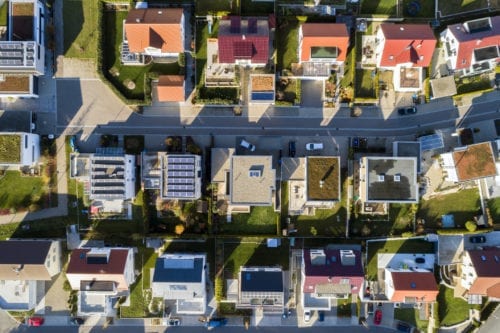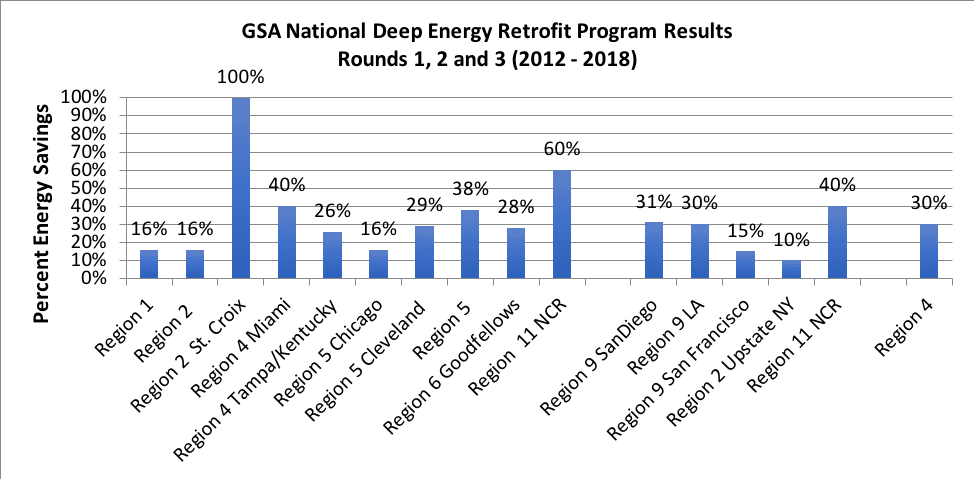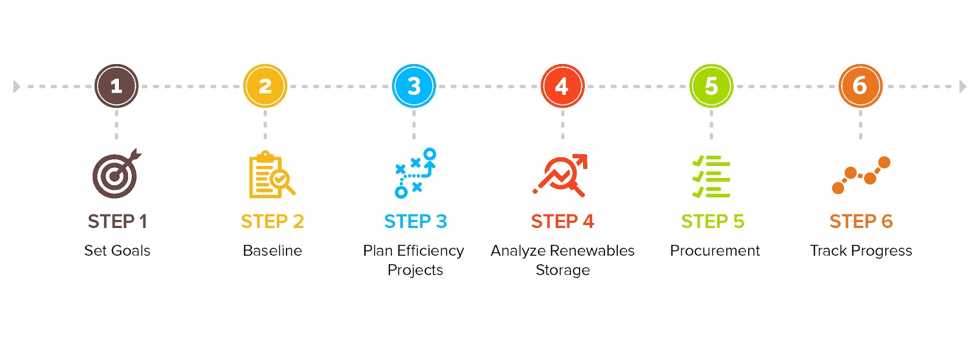
Making Our Existing Buildings Zero Carbon: A Three-Pronged Approach
To keep average global temperature rise to less than 1.5°C—which the IPCC states is necessary to avoid climate catastrophe—we need to fix our buildings. They are the largest end-users of energy, producing nearly 40 percent of US carbon emissions. Today, only a small fraction of our buildings do not produce carbon emissions. And most of these buildings are new construction, not retrofits. The big question is how do we retrofit millions of buildings cost-effectively, to be zero-carbon buildings?
The scale of this effort is substantial: In the US, there are 113 million buildings, 70 million of which burn natural gas or other fossil fuels for heating and cooking. To keep warming below 1.5°, we need to reduce emissions from buildings by 45–50 percent by 2030, on the way to 100 percent by 2050. Given the slow capital investment cycle in buildings, that likely means that we need to retrofit nearly half of our buildings to zero emissions by 2030, rather than retrofit all of our buildings to half emissions by then. Essentially, every building we touch over the next ten years, and we likely need to touch about 5 million buildings per year in the US, needs to be brought to zero emissions in a way that is both cost-effective and supports decarbonization of the grid.
How Buildings Need to Change
To do this, we need to focus on three things.
- Electrification of end uses: First, we must take natural gas completely out of the equation and have all of our end uses powered with electricity from a low-carbon electric grid. The 70 million homes and businesses across the country that burn natural gas, oil, or propane on-site, generate 600 million tons of CO2 each year—a tenth of total US emissions. Factor in the latest estimates of methane leakage, and that number rises to as much as one billion tons. As the electric grid becomes increasingly low carbon, we have the opportunity to meet nearly all our buildings’ energy needs with electricity, eliminating direct fossil fuel use in buildings and making obsolete much of the gas distribution system—along with its costs and safety challenges.
- Grid-interactivity: Second, We need to make our buildings grid-interactive, meaning responsive buildings that can ramp energy use up or down depending on the cost or carbon intensity of the utility generation source. If we electrify end loads without doing this, we will make the job of decarbonizing the grid more difficult, and ultimately more expensive. Grid-interactive buildings can help utilities ensure the balanced, flexible supply and demand of high levels of renewables and decarbonize the electricity system. These buildings can also save money for building owners, occupants, and utilities.
- All cost-effective efficiency: Third, we need to do all cost-effective efficiency measures, which can lower the cost of the first two efforts, improve comfort and building performance, and improve the payback on the billions of dollars of capital this nationwide effort will entail.
Doing all three of these things, not necessarily in that order but to all buildings, will be critical to simultaneously and cost-effectively decarbonize both existing buildings and the grid. The good news is that the technology exists to tackle all three of these efforts in nearly all buildings in the US already. Unfortunately, making buildings efficient, grid-interactive, and all-electric is the exception rather than the rule, especially for retrofits. So how do we change that while massively increasing the scale?
Tackling the Scale of the Problem
Retrofitting more than 70 million buildings around the country seems like a huge undertaking. On top of doing the usual energy efficiency steps, such as weatherizing our homes and businesses and increasing our appliance standards (which globally results in 1–3 percent improvements in productive energy use in buildings per year), we will also likely need to adopt some new approaches. Here are a few RMI is prioritizing: (1) increasing adoption of deep, whole building retrofits for our largest buildings and any building that will have a major capital investment in the next decade, (2) implementing zero-over-time calendars for most other buildings, allowing a deep energy retrofit to be spread out over major trigger points in a building’s lifecycle, and (3), developing new business models that can standardize and lower the cost of retrofits while delivering them at a massive scale.
Deep Retrofits
There are a number of buildings that will need major investments over the next decade. For these, there is almost always an opportunity to find deeper savings and end up with a better building by taking a whole-systems approach. By considering the whole building, we can often find opportunities to save energy that aren’t immediately obvious, such as investing in the building envelope in order to save on the HVAC system. A deep retrofit goes beyond regular efficiency measures to achieve much larger energy cost savings—sometimes over 50 percent reduction—than those of conventional, simple retrofits and fundamentally enhances the building value. For example, our deep retrofit of the historic Byron Rogers Federal Building achieved more than 60 percent energy savings through integrative design.
In fact, federal buildings around the country are ripe for deep retrofits. “US federal buildings make up one of the largest portfolios of buildings in the world,” says Cara Carmichael, a principal in RMI’s buildings program. “Deep retrofits on these buildings provide a great opportunity to save energy and money, create jobs, and stimulate economic growth—all while contributing to CO2 reduction goals.” RMI’s work with the US General Services Administration (GSA)—the nation’s largest landlord—helped the GSA to more than double the average federal energy savings of 18 percent to 38 percent in a group of 10 projects awarded in 2012, totaling $172 million in investment. On average, the GSA saved 33 percent across all of its performance-based contracts that have been executed since 2012 (representing improvements on 35 million square feet).
While deep retrofits can be cost-effective when you have a trigger, such as a capital improvement cycle or upgrades needed to meet a new stricter code, not all buildings will have such a trigger in the next decade.
Zero Over Time
For other buildings, it is important to take a zero-over-time (ZOT) approach. The ZOT approach helps portfolio owners and managers right-time deep energy efficiency, renewable energy, and energy storage projects by spreading them out over the life of the building based on “trigger points” in the building’s lifecycle, like a tenant fit-out or major equipment replacement. While most owners will just replace broken equipment, having a pre-planned zero-over-time approach means the owner will know exactly which investments become cost-effective when that event finally does happen. The approach focuses on long-term planning to deliver a series of cost-effective projects over about 20 years that, together, can amount to zero energy status for an entire portfolio while increasing revenues. RMI has laid out six steps for achieving net zero energy cost-effectively over time.
Standardizing Retrofit Delivery
To meet the scale and pace required to meet a 1.5° climate scenario, we also need new tools and approaches, specifically to standardize and simplify the retrofit process. Ideally, we need to find a way to deliver retrofits proactively, with financing, rather than waiting for owners to ask for them and finance the project themselves.
It’s not clear that there is a silver bullet approach to delivering standardized retrofits at scale, but there has been a proliferation of attempts recently. In addition to simple approaches like appliance swaps, there is increasing interest in taking advantage of new technologies, including from the prefabricated manufactured building sector and remote sensing. Perhaps the most ambitious recent project has been Energiesprong, out of the Netherlands, which attempts to deliver a standardized zero carbon retrofit in as little as a day per unit, to large portfolios of public housing. A public-private partnership, Energiesprong has cost-effectively implemented nearly 5,000 zero energy retrofits over the past five years, with another 100,000 planned across Europe. RMI’s REALIZE program is working on adapting this approach to the US context, including our different housing stock, climate zones, and financing structures, through our REALIZE program. “Today, every retrofit is a custom job, involving significant time, complexity, and cost,” says Martha Campbell a principal leading RMI’s REALIZE initiative. “Our goal is to deploy high-quality, prefabricated mass-scale retrofit packages that are easy to install and are financed through utility cost savings.”
Buildings Are Key
For the energy transition to be successful, we must consider our buildings. Drastically reducing if not completely eliminating emissions from the 113 million buildings in the United States is crucial if we are to keep temperature rise below 1.5°C. The scope and scale of this challenge will require both doubling down on existing approaches, as well as many new ones. For smart service providers and investors, it can be an incredible business opportunity. For more information on how RMI plans to reduce the emissions from our buildings sector, visit rmi.org.



